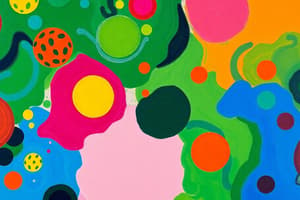Podcast
Questions and Answers
What roles do the kidneys perform in the body?
What roles do the kidneys perform in the body?
- Excretion and osmoregulation (correct)
- Respiration and nutrient absorption
- Detoxification and digestion
- Temperature regulation and immunity
Which substance is specifically removed from the blood by the kidneys?
Which substance is specifically removed from the blood by the kidneys?
- Urea (correct)
- Proteins
- Glucose
- Oxygen
What is the average volume of blood filtered by the kidneys daily?
What is the average volume of blood filtered by the kidneys daily?
- 180 dm3 (correct)
- 250 cm3
- 90 dm3
- 120 cm3
Which of the following is NOT a main function of the kidneys in osmoregulation?
Which of the following is NOT a main function of the kidneys in osmoregulation?
What percentage of human nephrons are classified as cortical nephrons?
What percentage of human nephrons are classified as cortical nephrons?
What feature of juxtamedullary nephrons contributes to their efficiency in urine concentration?
What feature of juxtamedullary nephrons contributes to their efficiency in urine concentration?
How often does all the blood in the body pass through the kidneys for filtering and balancing?
How often does all the blood in the body pass through the kidneys for filtering and balancing?
What happens to cells when water enters them by osmosis?
What happens to cells when water enters them by osmosis?
What role do the kidneys play in water balance?
What role do the kidneys play in water balance?
Which process is responsible for converting ammonia to urea?
Which process is responsible for converting ammonia to urea?
How does osmoregulation influence the cell's cytoplasm?
How does osmoregulation influence the cell's cytoplasm?
What organ is primarily involved in homeostatic control related to water balance in mammals?
What organ is primarily involved in homeostatic control related to water balance in mammals?
Why is the conversion of ammonia into urea important?
Why is the conversion of ammonia into urea important?
What substance do hepatocytes convert excess amino acids into after removing the amino group?
What substance do hepatocytes convert excess amino acids into after removing the amino group?
Which of the following describes osmoregulation?
Which of the following describes osmoregulation?
Flashcards are hidden until you start studying
Study Notes
Osmosis and Cell Dynamics
- Water movement in cells occurs via osmosis, balancing concentration inside and outside the cell.
- Imbalanced water concentration can lead to cell swelling and bursting or shrinking and loss of function.
Osmoregulation
- Osmoregulation maintains osmotic potential by controlling water and salt concentrations within narrow limits.
- Land-dwelling animals must conserve water and consume water directly.
- Tissue fluid surrounding mammalian cells originates from blood capillaries.
Role of the Kidney
- Kidneys are the primary organs for homeostatic control of water balance in mammals.
- The liver also contributes to homeostasis, including the breakdown of excess amino acids and removal of toxins.
Liver Functions in Homeostasis
- The liver performs around 500 functions, crucial for homeostasis.
- Deamination occurs in the liver where excess amino acids are processed by hepatocytes.
- The amino group from amino acids is converted into ammonia, then urea, less toxic for kidney excretion.
- The ornithine cycle facilitates the conversion of ammonia into urea.
Osmoregulation in Mammals
- Mammalian osmoregulation is primarily conducted by the kidneys, producing hypertonic urine to conserve water.
- Kidneys are dark reddish-brown organs located in the abdominal cavity, protected by fat.
Key Functions of Kidneys
- Control water potential of blood plasma.
- Remove urea and substances affecting water balance.
- Blood plasma passing through kidneys is filtered, creating urine stored in the bladder.
Kidney Structure and Functions
- Kidneys serve both excretion (urea removal) and osmoregulation functions.
- Approximately 120 cm³ of blood passes through kidneys per minute; all blood is filtered roughly every hour.
- Daily filtration is about 180 dm³.
Nephron Structure and Function
- Kidneys consist of nephrons, microscopic tubules measuring 2-4 cm long, with around 1.5 million nephrons per kidney.
- Main nephron functions include:
- Ultrafiltration
- Selective reabsorption
- Tubular secretion
- Two main types of nephrons:
- Cortical Nephrons: Predominantly in the renal cortex with short loops of Henle; about 85% of human nephrons.
- Juxtamedullary Nephrons: Have long loops of Henle penetrating the medulla; efficient in producing concentrated urine.
Studying That Suits You
Use AI to generate personalized quizzes and flashcards to suit your learning preferences.




